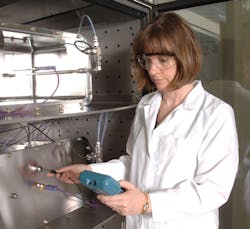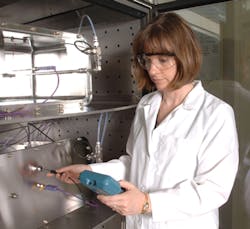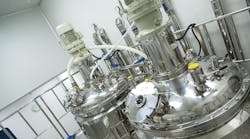Researchers at the National Institute of Standards & Technology and Virginia Tech are readying the release of a new method of measuring hazardous indoor air pollutants.* The measurement tool, a reference sample for volatile organic compounds (VOCs), world be a boon to testers of indoor air quality and to manufacturers of paints, rugs, cleaners and other building products, according to the NIST.
The researchers put their innovation — thin squares of plastic saturated with vapors of a common solvent — through the paces at four testing laboratories. The prototype test material, made at Virginia Tech, yielded measurement results more accurate than those previously achieved in more costly and time-consuming inter-laboratory studies using less standardized materials.
The researchers suggest that their method might be used to produce a range of reference materials to validate measurements of VOCs emitted from building materials and products. VOCs are used in paints, adhesives, furniture and other indoor products. Indoor levels of some VOCs average two to five times higher than outdoors, according to the U.S. Environmental Protection Agency.
VOC emissions from building materials and products have been linked to occupant illness, reduced worker productivity, and increased requirements for ventilation/air cleaning, leading to increased energy consumption. As a result, low VOC emitting products are being used more widely in buildings to help achieve a healthy and sustainable indoor environment.
Several programs for testing VOC emissions from building products exist, and manufacturers often test their products to determine that emissions are below limits set in regulations or voluntary standards. However, results often vary significantly.
Past evaluations of test performance have been based on how much measurements reported by individual laboratories differ from the average value for the entire set of laboratories. “These kinds of inter-laboratory comparisons can take months to conduct,” explains NIST environmental engineer Cynthia Howard-Reed, lead author of the new report, “and, unfortunately, the results are relative because there is no true reference value for determining just how accurate an emission measurement really is.”
That’s the gap the researchers are trying to fill. They aim to produce VOC reference materials — standardized test samples that produce known results when analyzed. These benchmark references are commonly used in industry to check the accuracy of important measurement instruments.
In the initial trial, they prepared two batches of their sample material — thin films of polymethyl pentane, a plastic used in gas-permeable packaging, saturated with toluene, a common VOC found in paint and other products. A mathematical model developed by the research team is used to accurately predict rates of emission from the sample over time. The preliminary multi-laboratory tests showed that the prototype reference material is uniform in composition and sufficiently stable and that rates of VOC emissions within and between production batches are consistent.
The researchers conclude that their prototype could reduce inter-laboratory variability in results to less than 10 percent — much better than current methods.
The pilot study also identified several opportunities for improvement, which will be incorporated before an international pilot is conducted later this year. With further progress, the project will be expanded by 2013 to include more types of VOC references that will be produced in larger batches for broader distribution.* C. Howard-Reed , Z. Liu, J. Benning , S. Cox, D. Samarov, D. Leber, A.T. Hodgson, S. Mason, D. Won and J.C. Little. Diffusion-controlled reference material for volatile organic compound emissions testing: Pilot inter-laboratory study. Building and Environment 46 (2011) 1504-1511.



